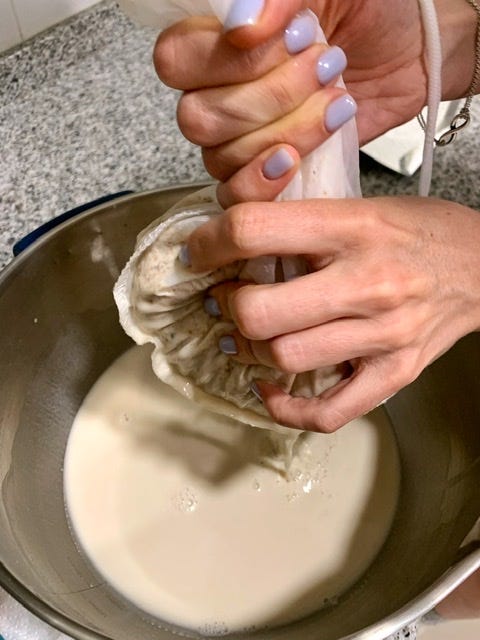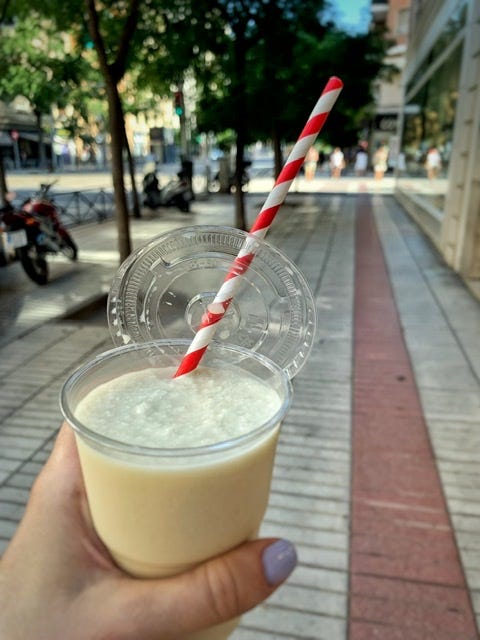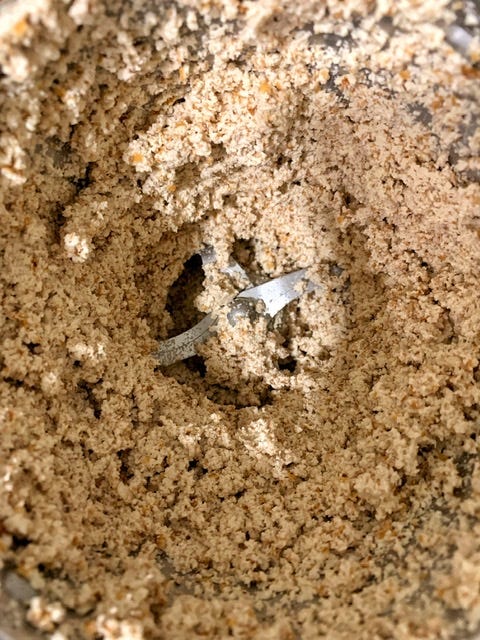In [the summer] drinking horchata
Adventures in making homemade horchata de chufa, a brief history of the (plant-based) milky drink, and trying to get the song referenced above out of my head. Recipe inside!
You know when you get a song in your head and you can’t get it out? But like, even though you know more lyrics, only one brief part of the song just repeats over and over again in your mind? That’s what I’ve been dealing with the past week or so with the song “Horchata” by Vampire Weekend.
In the Substack food world, summer drinks are all the rage right now: Anne Byrn recently wrote about sangria, and Jolene at Time Travel Kitchen wrote a tribute to granitas (including a link to a recipe by Domenica at Buona Domenica). All of this beverage talk made me start to think about summer drinks here in Spain. Like Anne mentions in her newsletter linked above, tintos de verano1 are typically more common among locals than sangria. But one drink that locals and tourists both enjoy during Spanish summers is horchata, which is a sweetened plant-based milk.
Something important to note about horchata is that the kind that most people are exposed to in the US is the Mexican preparation, which is usually made with a rice base. In Spain, the drink is made with something called chufas, or tiger nuts in English. Interestingly, tiger nuts are not actually nuts but edible tubers. Like paella, horchata de chufa has its origins in Valencia, but it’s become popular all over Spain as a refreshing summer beverage. It’s common to drink horchata on its own, but sometimes it is also served with fartons, which kind of look like long, thin donut sticks. The idea is to dip the fartons in the drink to soak up the sweet, milky goodness.
Of course, thinking about horchata immediately made the Vampire Weekend song pop into my head: “In December, drinking horchaaaata…” This was fine for the first few hours or so, but then I started waking up with it on mental repeat every day. Initially I thought that just listening to the song would help. Ha! If only it were so simple. I decided that the only thing I could do to get rid of the ear worm was get the drink in real life. In the few times I had tried horchata previously, I’d liked it but I wasn’t necessarily a huge fan. But if I’ve learned anything from the past, it’s important to keep trying things because sometimes taste develops over time (like for gazpacho!), so off I went in search of the drink.
To retry the tiger nut milk, I went to one of the most mythical horchaterías in the city: El Kiosko de Horchata Miguel y José. Situated in Calle Narváez since 1944, the history of the horchatería goes all the way back to 1910 (you can read the story of the family business here). According to its website, until 1990 the drink was prepared right there in the kiosk. They brought the tiger nuts (already ground) in sacks, added water, and ran the mixture through something similar to a filter press to extract the milk. After stirring in sugar, they poured the liquid into jars and popped the containers into the fridge to get the beverage ice-cold. Actualmente2, due to sanitary regulations, the horchata is made in batches in a small nearby almacén3 and transported to the kiosk to be enjoyed by the masses.
I don’t know about you guys, but I love a good backstory on how something was named, and the legend of how the word “horchata” came to be doesn’t disappoint. According to the plaque on Miguel and José’s kiosk, the name is inspired by a tale from the time of La Reconquista. The story goes that a village woman offered the drink to King Jaime I of Aragón. The king loved the drink so much that he asked the woman what was in it, to which she responded “Llet de xufa”4 (leche de chufa/tiger nut milk). King Jaime exclaimed, “Aixo no es let, aixo es or, xata!” (Esto no es leche, esto es oro, chica!/This isn’t milk, this is gold, girl!). From the last two words “or” + “xata” we get “orxata,” written as horchata in modern-day Castilian Spanish.5 Fun, right? (The RAE tells us that the origin is in fact from the Italian word orzata, which comes from the Latin orzo + ata. Orzo is cebada in Spanish, or “wheat” in English. I like the legend better but in the spirit of accurate reporting, my conscious wouldn’t let me not include this tidbit.)
Miguel and José offer several types of drinks, including agua de cebada and even sugar-free horchata, but I went with the classic. Even though I had previously been on the fence about horchata, I actually liked the drink quite a bit. It was sweet, creamy, and refreshing all at the same time. Plus it had little bits of iced milk—granita-style—floating throughout, which was much appreciated on a hot Madrid afternoon. So mission complete, right?
Unfortunately, the next morning I woke up humming Vampire Weekend again. Drinking horchata did not, in fact, expel my ear worm. Naturally, the only thing I could do to stop annoying everyone in my house (but my mostly myself) was make horchata at home.
The first step was to find the tiger nuts, which was easy enough. Thanks to Casa Ruiz, which is a bulk grain and spice store with shops in both Madrid and Barcelona, I was able to buy authentic Valencian chufas. The tiger nuts come dried, so the next step was rehydrating them by soaking them in water. The recipes I had found called for soaking them at least eight hours, but recommended overnight. I checked the chufas after about three hours and they were hard, and after six hours had passed and I tested them again and they still felt like little stones. Frustrated, I decided to try to bite one, and to my surprise it easily popped open. I probably could have forged ahead with the recipe after the eight hours, but I settled on waiting until the next day just in case.

After rinsing and draining the chufas, the recipe went fairly quickly. I enlisted David as my sous chef (usually it’s the other way around), and we added both the chufas and an equal amount of water to our vintage Thermomix. After blending for a few minutes, we were left with a thick paste, as you can see in the picture below.
Next, we placed the paste in the fridge for a couple of hours (this was suggested as an optional step in one of the videos I had watched). Once the time was up, we added the remaining amount of water to the paste and used a whisk to mix it all together. Then, it was time to separate the actual milk: we used a yogurt mesh, but you could use cheesecloth or probably even coffee filters in a pinch (the lead picture shows this process). The last step was to add sugar. We did a highly scientific experiment6 and came up with a sugar percentage of 4%. For us that meant 40g of sugar to add to 1 liter of the strained milk. This was actually much less sugar than was called for in the original recipes that I referenced, and if you prefer your drinks sweeter there’s definitely room for additional sugar to taste. I would suggest starting with a lower amount and adding as needed. In fact, David and I both tasted the milk before sweetening and thought it was also good without sugar at all.
In the end, I was super pleased with how the horchata turned out! It was really simple to prepare, albeit you do have to plan ahead a bit to have time to soak the chufas. One thing I would maybe change in the future is the sugar: we used granulated sugar, which was the kind used in the video we had watched, but it did settle to the bottom of the drink at first, meaning that you have to be careful to stir the drink well if you’re serving it right away (as in if you’re impatient like me and can’t be bothered to wait for it to chill). A couple of other recipes that I had looked at used powdered sugar instead, which would likely eliminate this.
I have to confess, making the homemade horchata still did not get the Vampire Weekend song out of my head. But it did result in a delicious beverage! I’m already thinking of ideas of how to use it other than drinking it straight: freezing some in ice cubes to blend into a granita-style drink, or even serving with espresso on ice for an iced horchata latte (horcha-latte, perhaps?).
I’ve typed out a recipe for you below! Please feel free to comment with questions, or you can also email me directly. And be sure to let me know if you try it!
Horchata de Chufa
Yield: Approximately 1 liter of horchata
Special equipment needed
Blender (we used a high-speed blender, but you could also use an immersion blender or a regular blender)
Yogurt mesh or cheesecloth
Ingredients
250g chufas/dried tiger nuts7
40g granulated sugar
1 liter cold water
Additional water for soaking the dried tiger nuts
Directions
Add the chufas to a bowl, cover with water, and let soak for at least 8 hours. If you’re not using a high-speed blender, I would recommend soaking longer, up to 24 hours. You can leave the bowl on the counter or place it in the fridge.
After soaking, rinse the rehydrated chufas and drain well.
Add the chufas to the blender along with 250ml cold water.
Blend on medium-high speed for around 5 minutes, until the mixture is a thick paste.
Optional step: Transfer chufa paste to a large bowl and place in the fridge for 2 hours.
If you skip the above step, transfer the chufa paste from the blender to a large bowl. Otherwise, remove chufa paste from the fridge.
Add the rest of the cold water (750ml) to the bowl with the chufa paste and whisk/stir until combined.
Place yogurt mesh or cheesecloth over a separate bowl and pour chufa mixture inside. Using either a spatula or your hands, squeeze as much liquid from the mixture as possible so that only a paste is left in the mesh/cloth. Discard the paste.
Stir sugar into the strained milk, taste, and add more if desired!
Pour the horchata into your container of choice and place it in the fridge for a couple of hours before serving.
The horchata will stay good in the fridge for up to two days, but it can also be frozen. After sitting for a bit, there does tend to bit a bit of chufa powder that settles to the bottom. To deal with this, I just stirred before serving. If the settlement bothers you, you can either decant the horchata or strain one final time after adding the sugar. This may or may not be worth it since there will probably always be a bit of settlement.
Have you ever had horchata (either made with tiger nuts, or the kind made with rice or another base)? Do you have a favorite summer drink? Let me know in the comments!
Tinto de verano: A drink made with red wine mixed with either soda water or lemon.
Actualmente: Currently
Almacén: Warehouse
Llet de xufa: This is written in valenciano, which is the local language spoken in Valencia.
Castilian Spanish: The dialect of Spanish spoken in Spain.
On our scientific experiment: It actually just consisted of using a precision food scale and basic math.
On dried tiger nuts: I did some preliminary searching, and it looks like you can get chufas in the US on Amazon and possibly at Whole Foods.









I honestly thought it was the equivalent of our "orzata" but it's not! Curious to try it now. (Orzata is a syrup made of barley and bitter almond extract)
So glad that tinto de verano got a mention here bc it is my favorite “summer drink” in Spain!! But the horchata looks delicious and very cool that you made your own. Would love to know more about agua de cebada… barley water??